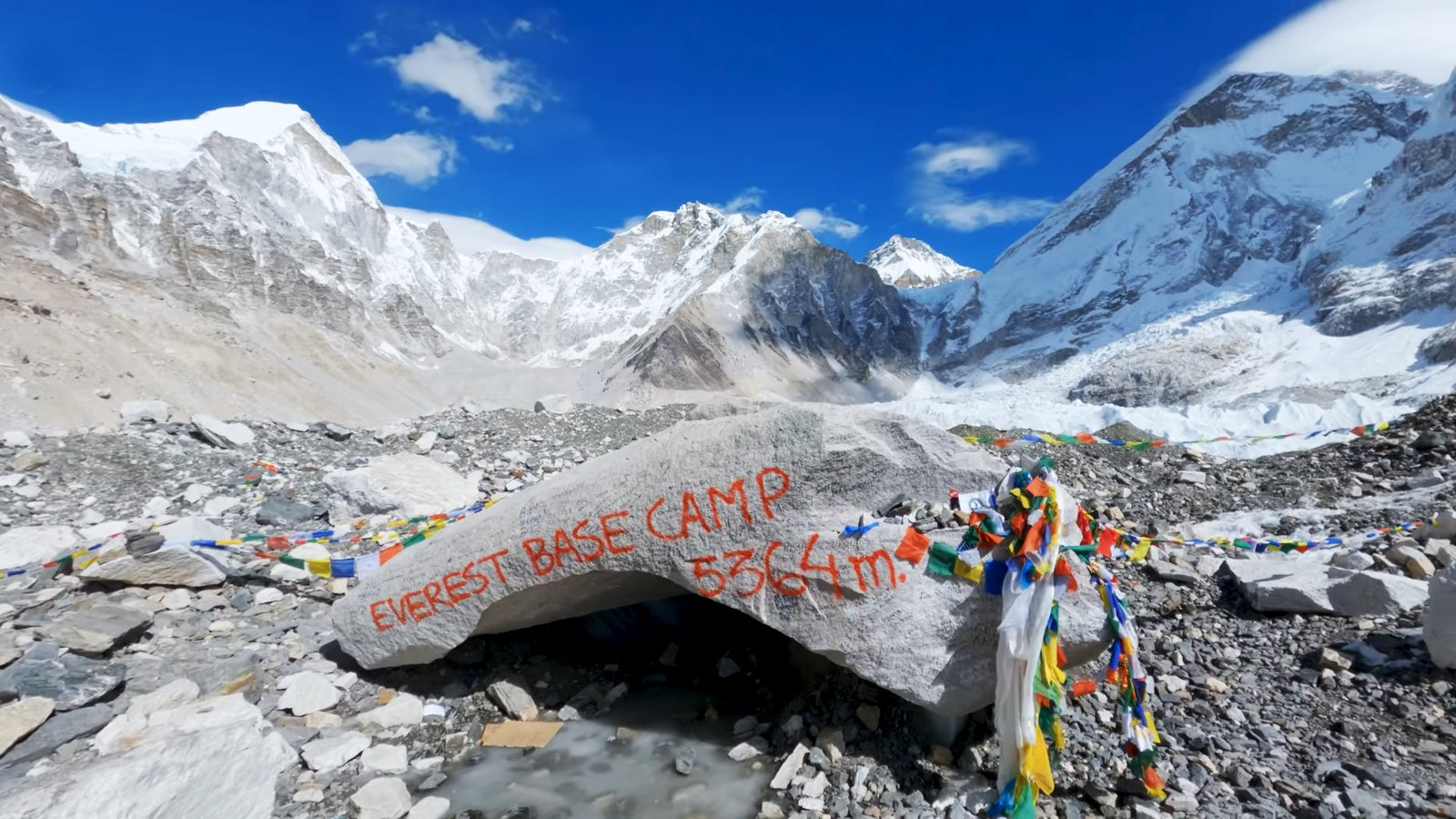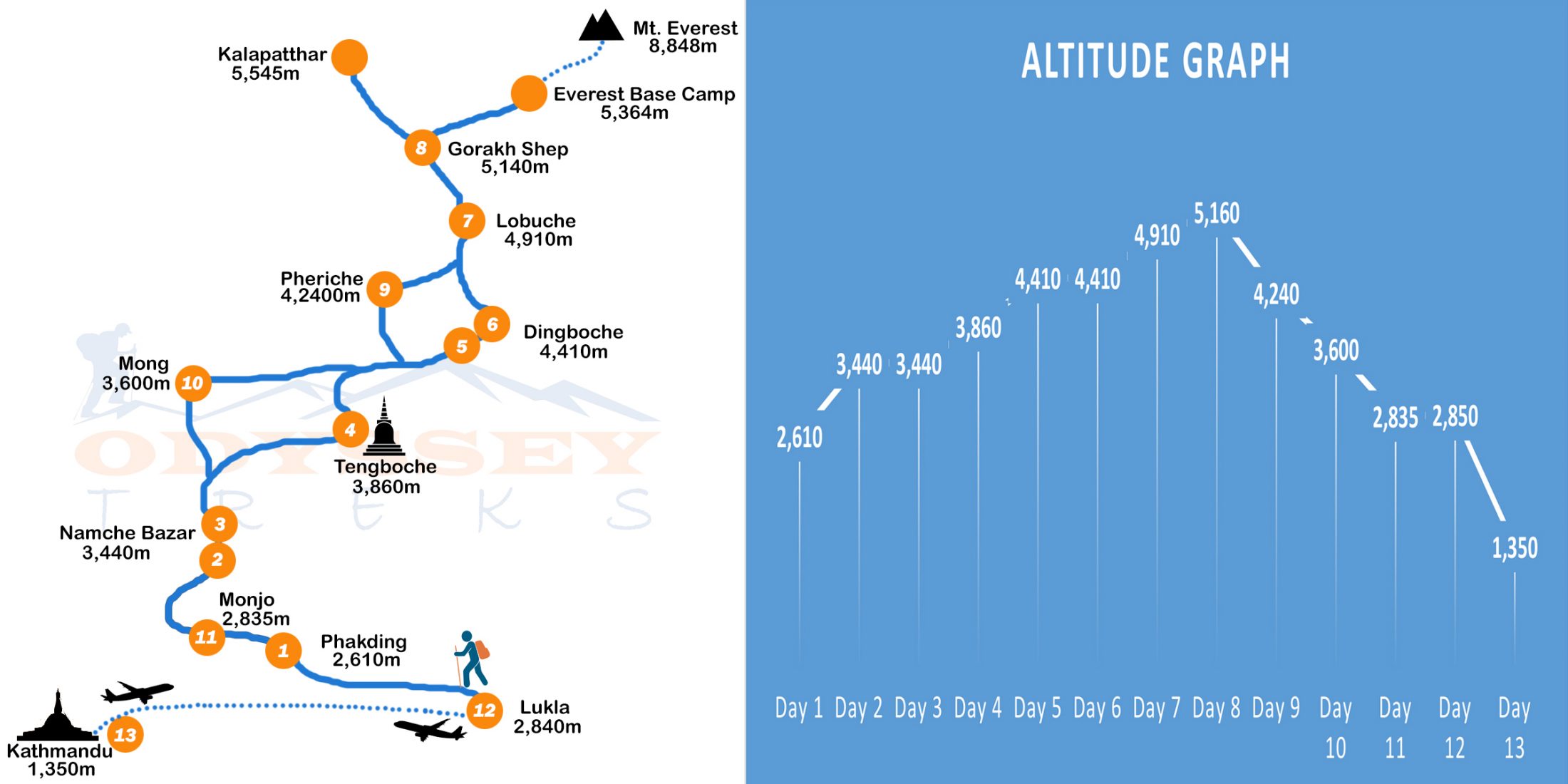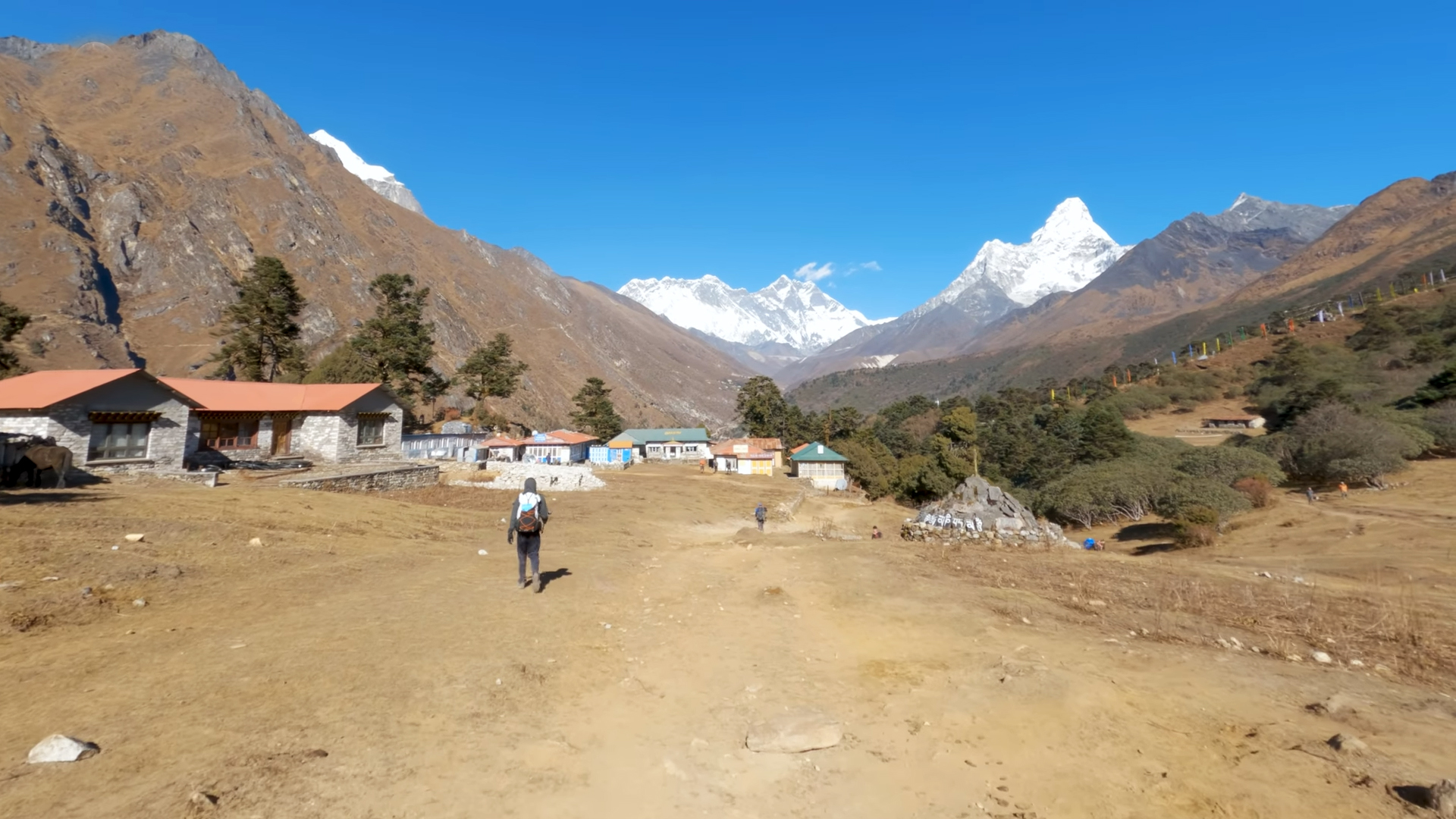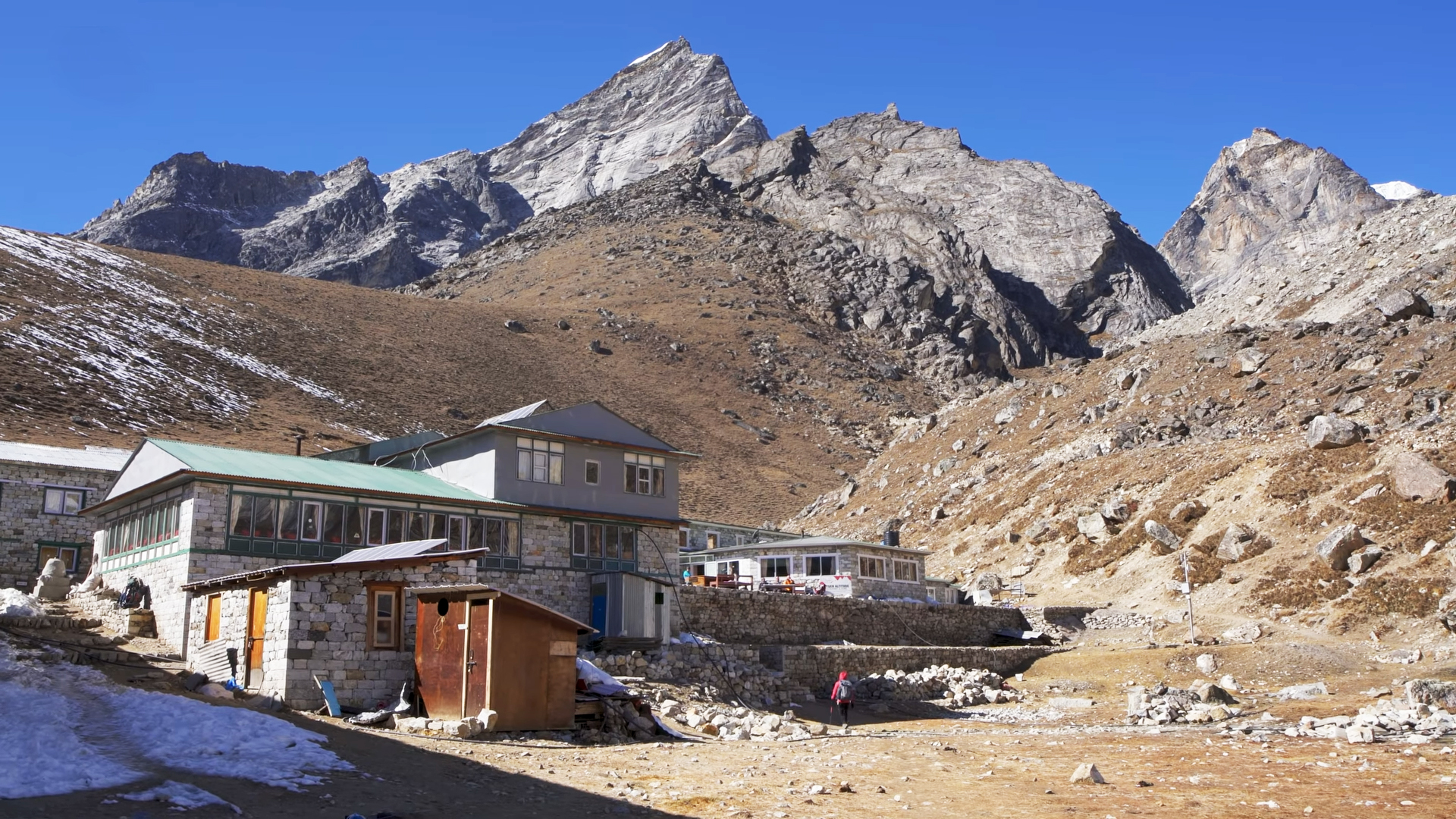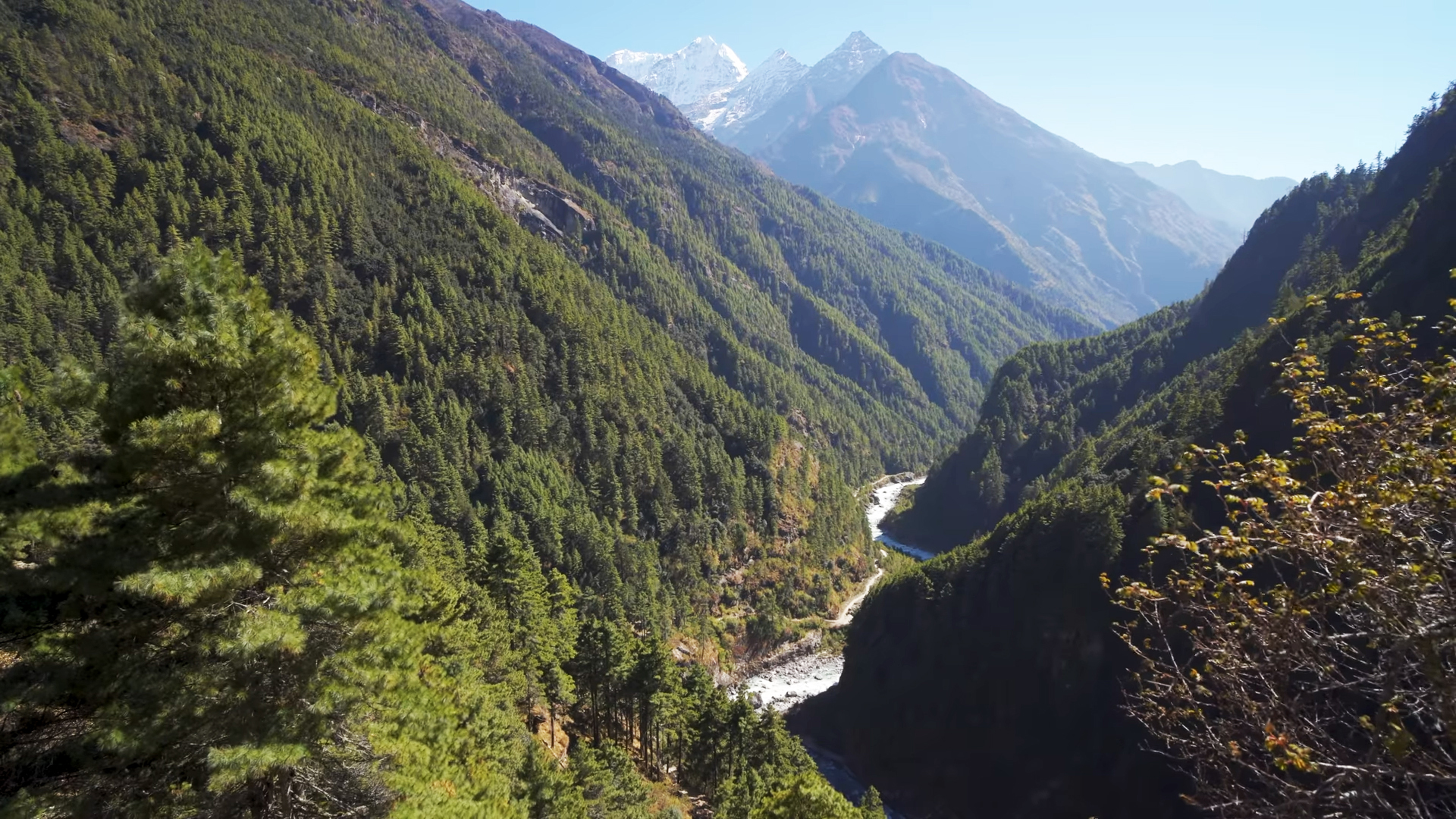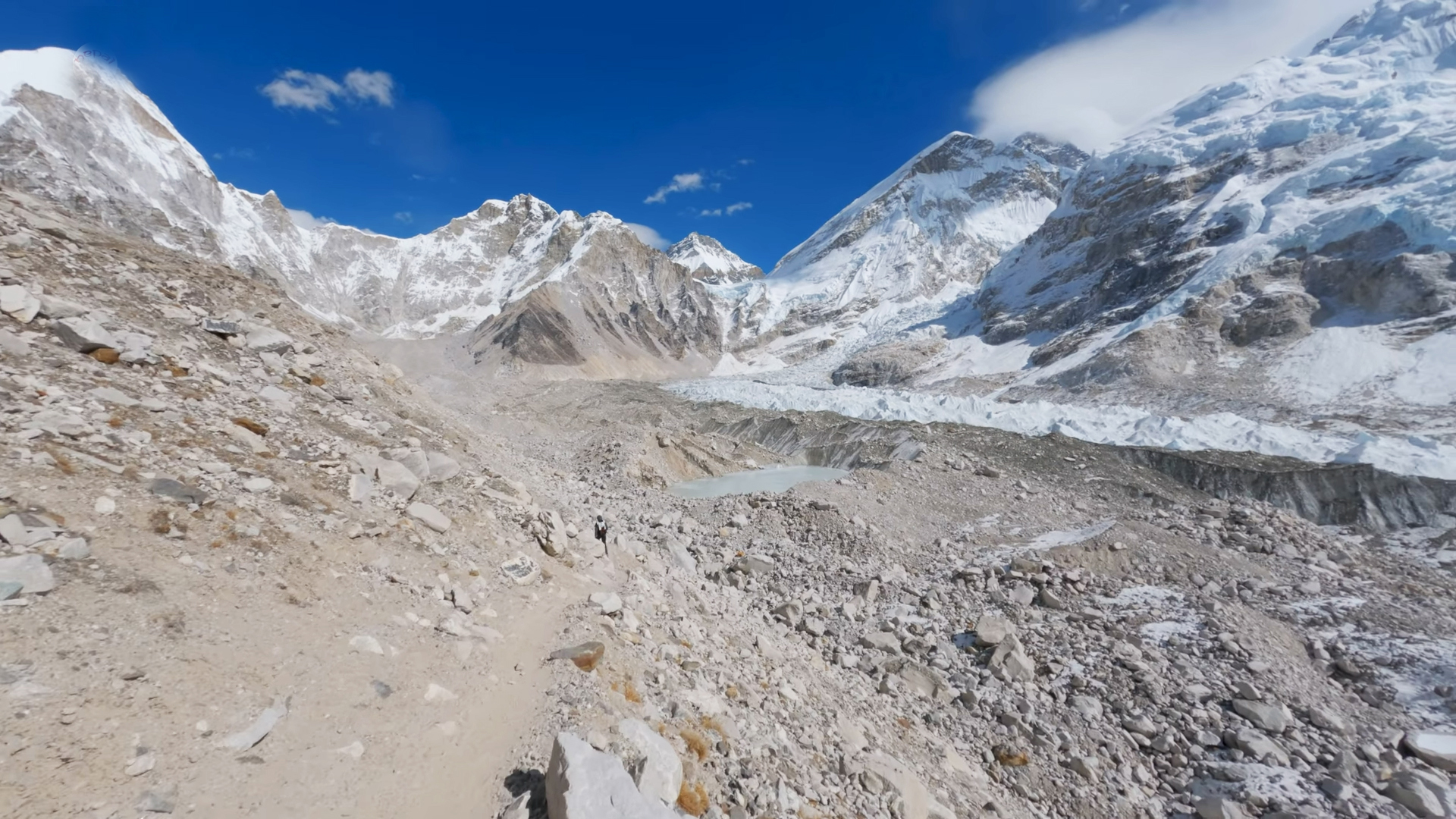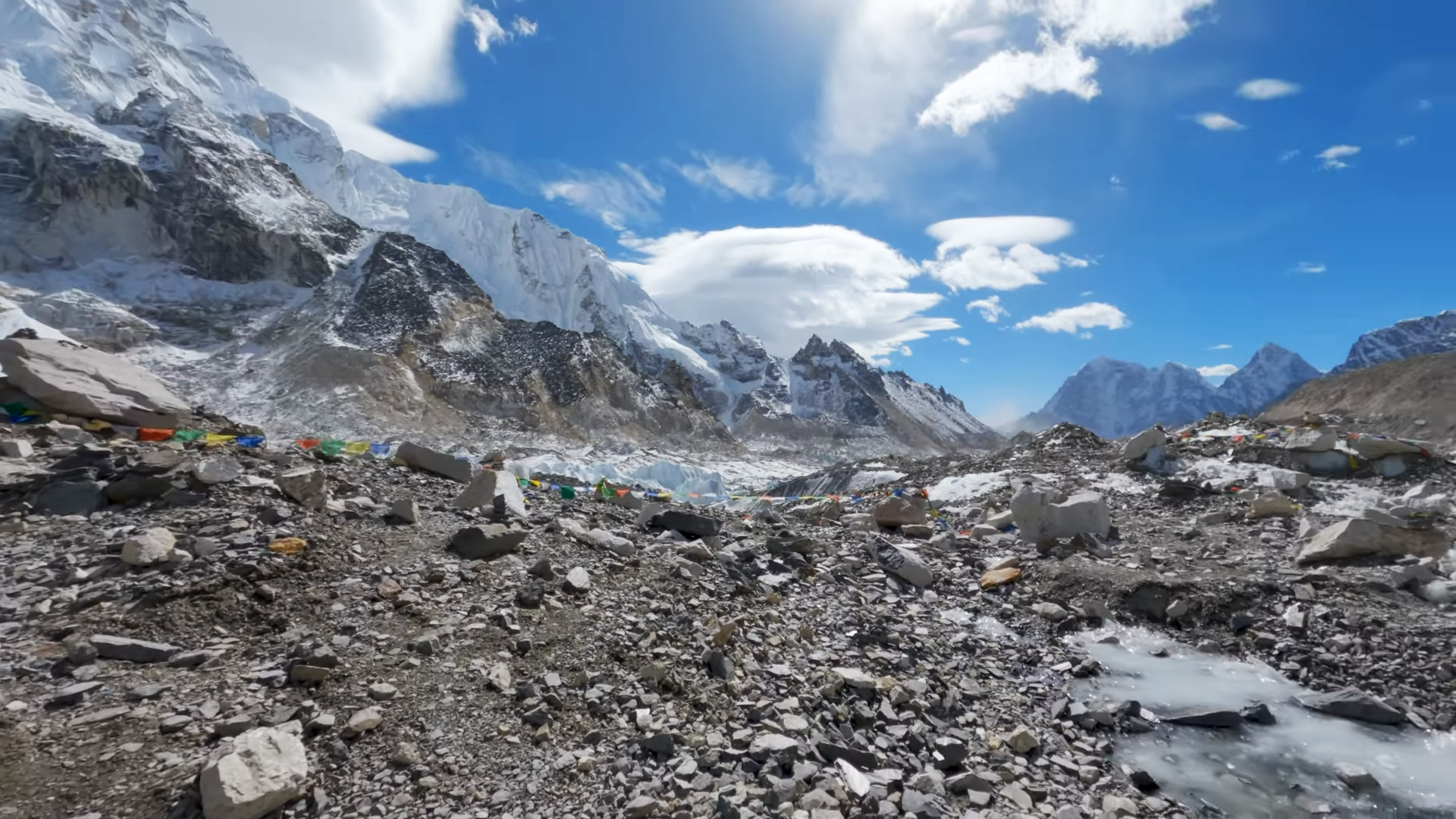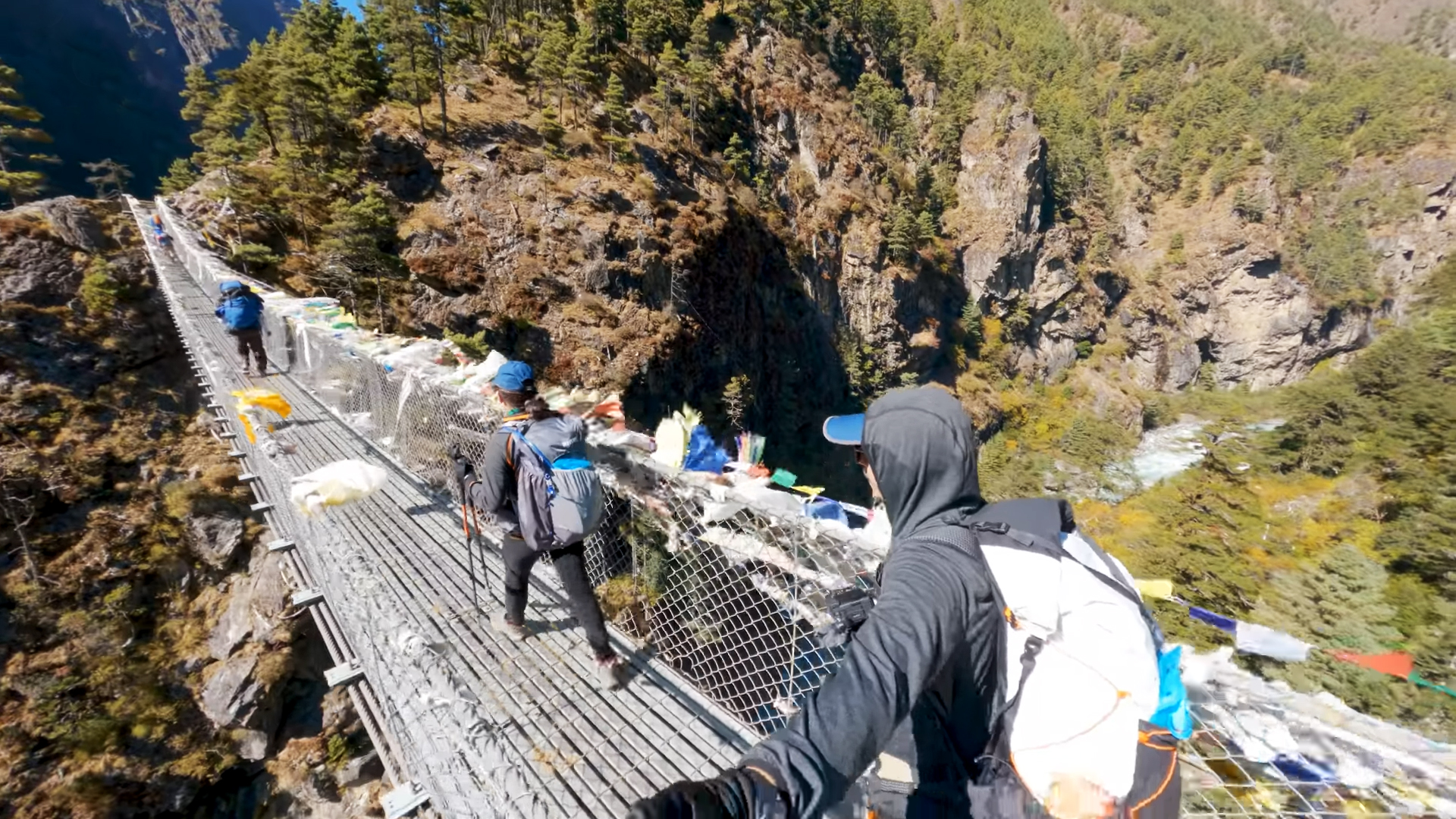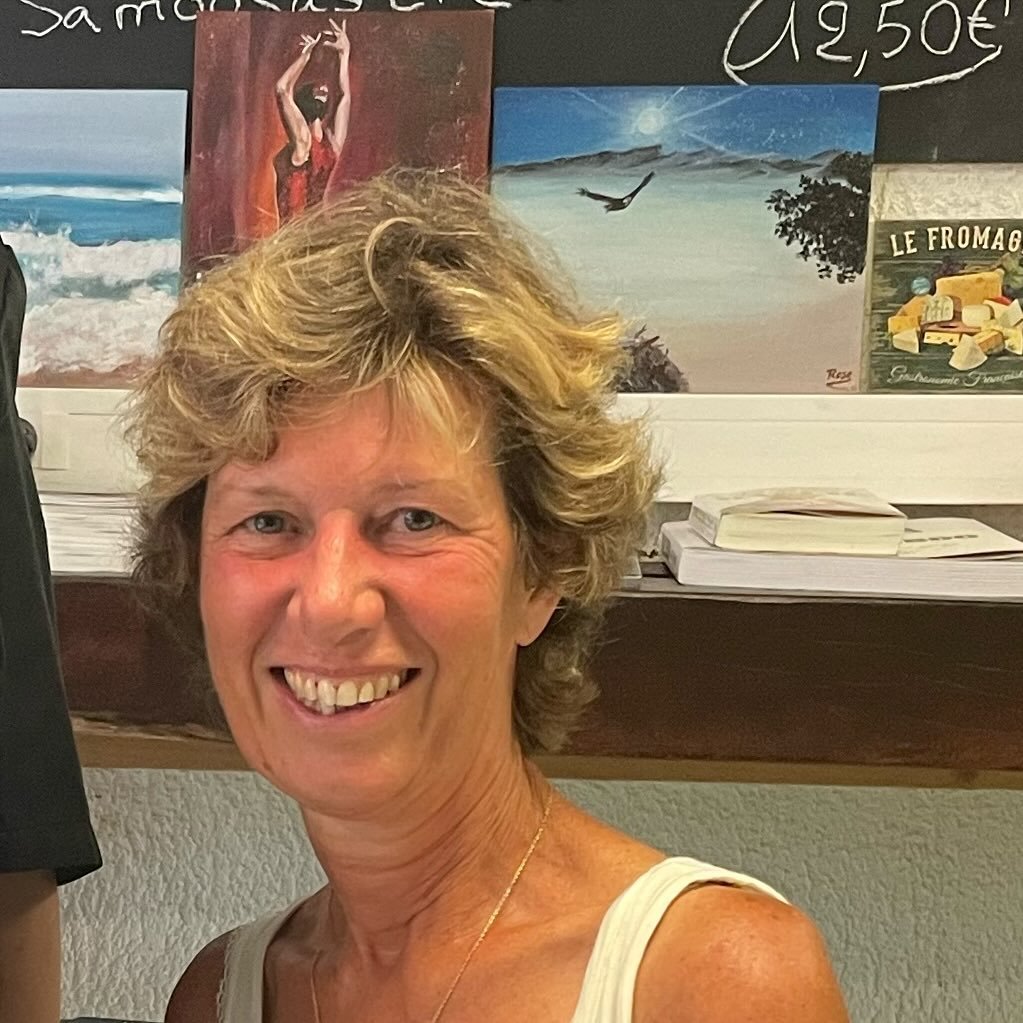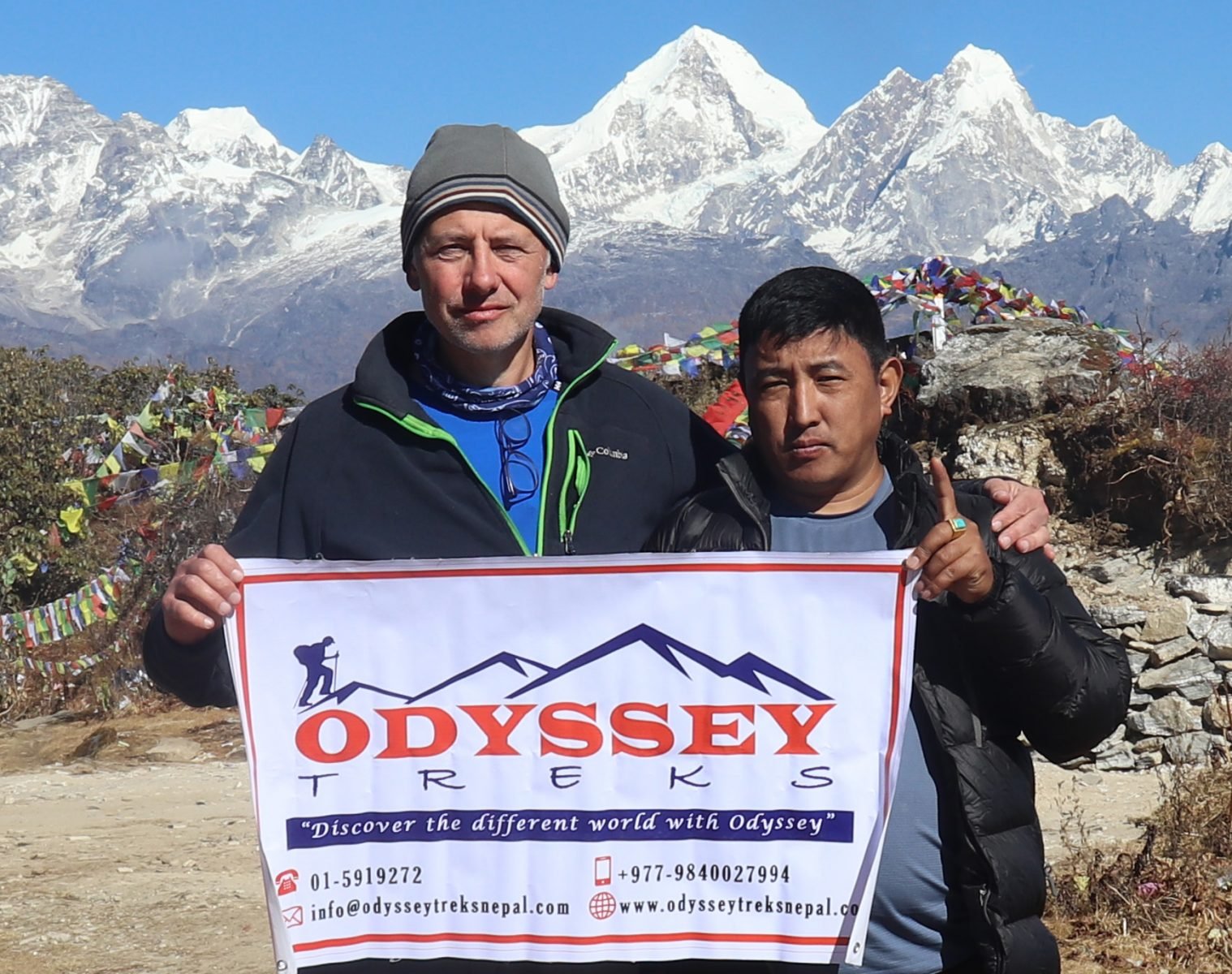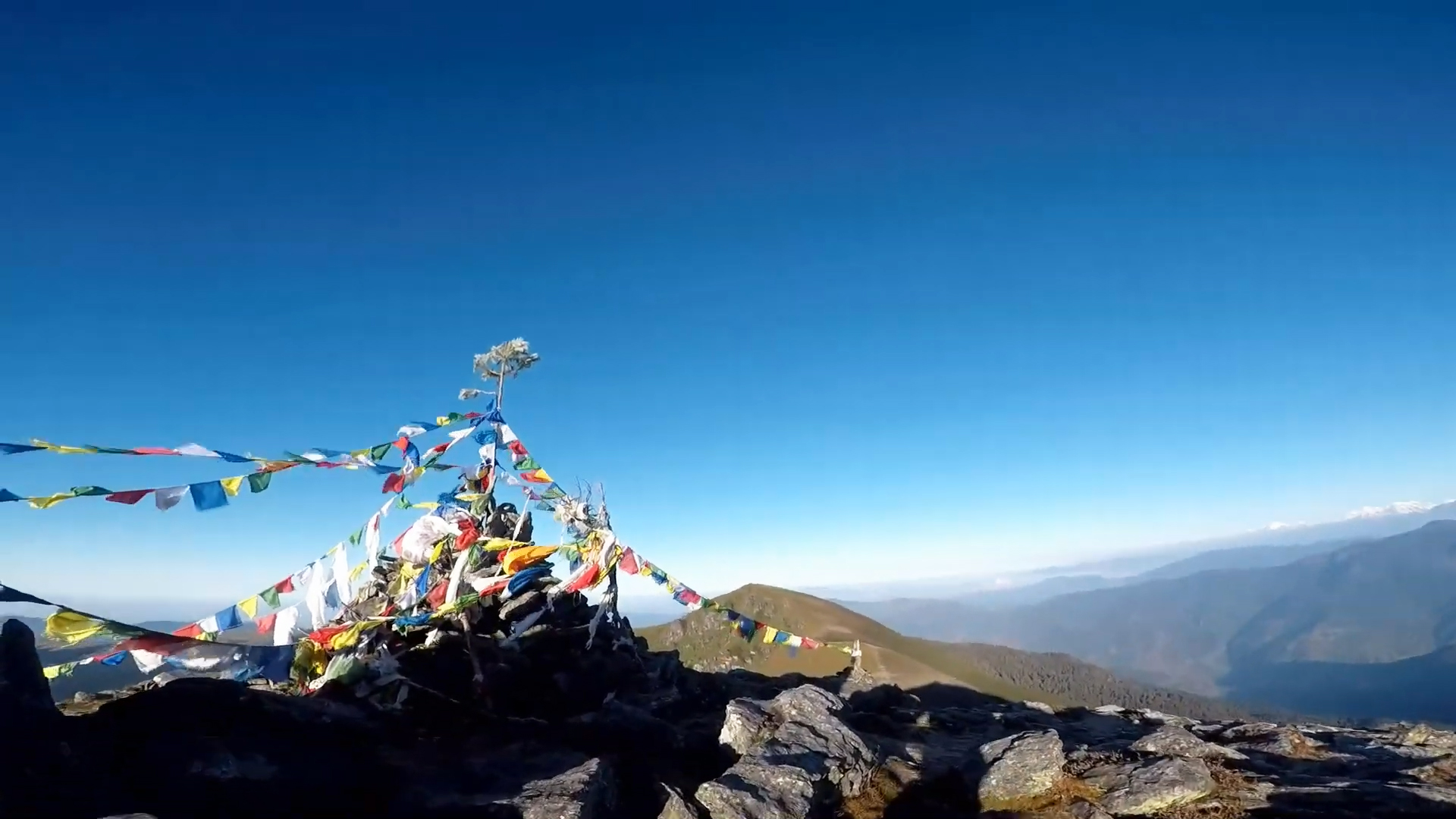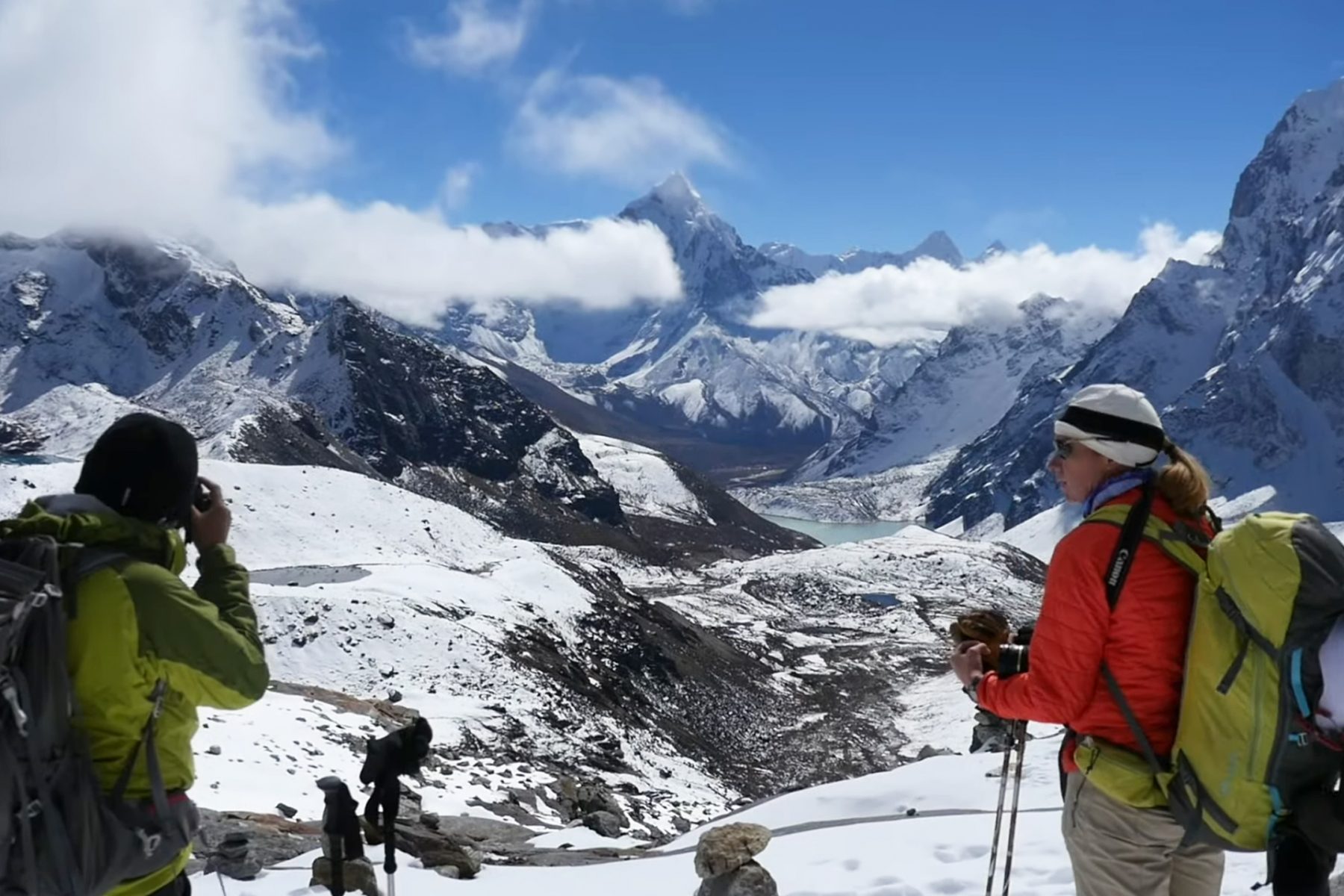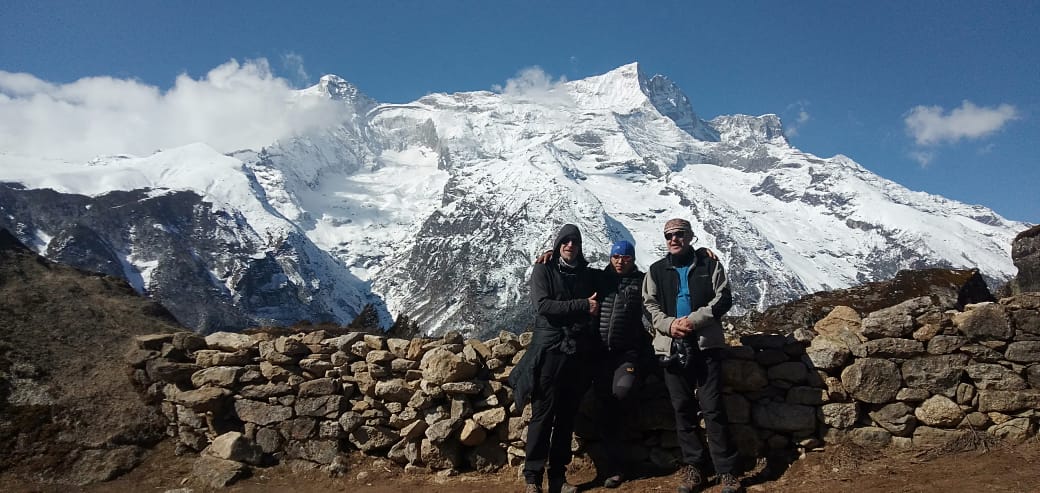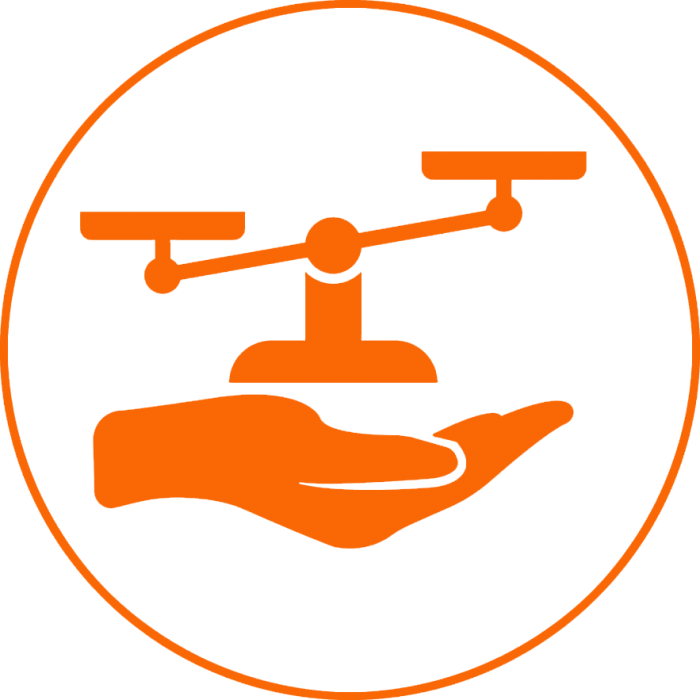Trip Overview
Introduction to Everest Base Camp Trek in Nepal
The Everest Base Camp Trek in Nepal takes you to the lap of the world’s highest peak. As the trek takes you above 5000 meters, this trek is also a center of attraction for many trekkers. This trek fulfills your dream of getting a close-up view of Mount Everest. Not only Everest but also other beautiful mountains around it have added beauty to this trek.
This trek is in the Everest region of Nepal, which is also the most famous region of Nepal for trekking. The Everest region is located in Everest National Park. This national park is the tallest national park in the world and is a UNESCO World Heritage Site.
About 30,000 tourists come to trek in this area every year, which shows how famous this trek is in Nepal. The Everest Base Camp Trek in Nepal is one of the most beautiful treks. This 13-day trip takes you to the lap of the world’s highest peak, Mount Everest, where your dreams come true.
Everest Base Camp Trekking in Nepal is one of the top three trekking destinations in the world, with magnificent mountain views. There are many trekking packages available here for mountain trekking. But the first choice of trekkers is always the Everest Base Camp Trek in Nepal. Due to all these reasons, the number of people coming to Nepal for trekking is increasing every year.
Everest Base Camp in Nepal is famous not only for visiting the world’s highest peak but also for many other things. This trek is also popular for visiting the Khumbu Himalayan Glacier, Khumbu Icefall, Tibetan Sherpa culture, ancient Tibetan monasteries, beautiful landscapes, wild animals, and green forests. The Everest base camp trek in Nepal allows you to see many amazing mountains.
Enjoy Views of the High Mountains
On this trek, you can enjoy the breathtaking views of mountains above 8,000 meters, like Mount Everest (8,848 m), Mount Lhotse (8,516 m), Makalu (8,481 m), and Cho-Yo (8,201 m).
The beautiful Himalayan scenery will not leave your eyes throughout the trip. Beautiful fields, magnificent mountains, stunning waterfalls, and pine and rhododendron forests will give you a unique and pleasant feeling. On the way to the base camp, you will pass many beautiful Sherpa settlements. The Sherpa tribe is a local inhabitant of the Everest region. The trip is also a chance to interact with the locals and learn about their culture, traditions, and lifestyle. The daily life of the people of this area is simple and attractive. Their warm hospitality will make you feel at home.
You may like: Annapurna Circuit Trek, 19 Days Itinerary, Cost, Package
Visit Monasteries
While trekking, you will get away from the busy city life, cars, conveniences, daily luxuries, etc., and enjoy the natural beauty. On the way, you will find many monasteries, prayer flags, and suspension bridges, which make the journey even more exciting. Along the way, visit beautiful Buddhist monasteries with prayer flags. You will feel the positive vibes while visiting the monasteries. The Everest Base Camp Trek in Nepal is not just a trip; it will be one of the best mountain treks you will do in your lifetime.
Although the main destination of this trek is Everest Base Camp, it is not the highest point of this trip. When we reach Everest base camp, we are the closest to Everest, but we cannot see Everest properly from there. So, you go to Kalapatthar to see the view of Everest and other beautiful mountains around. The highest point of this Everest Base Camp Trek in Nepal is Kalapathar, which is 5,550 meters high. The highest place where you spend the night during the trip is Gorak Shep, which is at an altitude of 5,140 meters.
Start Everest Base Camp Trek
On the first day of the Everest Base Camp Trek in Nepal, you will leave the hotel early in the morning for the airport. A short flight of 45 minutes will take you to the Tenzing Hillary Airport in Lukla, in the Everest region. This airport is at an altitude of 2,846 meters. Although the flight is short, it will be an exciting and scenic flight for you. After landing at the airport, you will feel some change in the weather. Lukla is also the starting and ending point of the trek.
From Lukla airport, you will start trekking to Phakding village (2,610 meters). On the way, you cross many Sherpa villages, green forests, and many suspension bridges. Your journey will continue towards Phakding village. The journey from Lukla to Phakding is short and pleasant, and you can reach it in 4 to 5 hours. After reaching Phakding, you can spend the rest of your free time visiting the village and the local monasteries.
Namche Bazar – Main Commercial Market of Khumbu Region
Next morning, after breakfast, you will be ready for the trek to Namche Bazar (3,440m). From Phakding, you begin your walk to Namche. Enjoy scenic views along the northern banks of the Dudhkoshi River. Namche is the largest and main commercial market in the Khumbu region. Along the way, you will find thousands of prayer flags and huge prayer wheels. You will also cross many suspension bridges, including the famous Hillary Suspension Bridge.
On the way, there is the Everest National Park check-post, where you will register the permit. After registering for the permit, you will continue your journey again. As Namche is a big and famous market, you can find all kinds of shops, hotels, and restaurants you are looking for. During the trekking season, you can find many tourists in Namche Bazar and trail. In Namche, visit the Sherpa Museum, where you will find art galleries and glimpses of Sherpa’s history. During your free time, enjoy Namche Bazaar and the view of the surrounding mountains.
Acclimatization in Namche Bazar
The next day is an acclimatization day, and you will stay in Namche. Acclimatization is essential to prevent altitude sickness and to adapt to your body. On this day, you can visit Hillary School, Sherpa Settlement, Sangboche Airport, and Yak Farms to keep yourself busy. If you are eager to catch a glimpse of Mount Everest, take a walk up to the Everest View Hotel. From here, you can see the view of Mount Everest and other beautiful mountains around.
Visit Also: Everest Cho La Pass Trek in just 16 Days, Itinerary, Cost, Distance
The next day, after breakfast, you will be ready for the trek from Namche to Tengboche (3,860m). The main attraction of this village is the famous Tengboche Monastery, which is at an altitude of 3,860 meters. This monastery is the largest and most famous in the Khumbu region. The Ama Dablam Mountain in the background adds to the beauty of this monastery. The beautiful Tengboche Monastery is a perfect place for meditation and prayer. So, don’t miss visiting this beautiful monastery while you are in Tengboche.
On the fifth day of the Everest Base Camp Trek in Nepal, after breakfast, you will walk to Dingboche. It takes 5 to 6 hours to reach Dingboche village at an altitude of 4,410 meters. From here, you can see the stunning view of mountains like Lhotse (8,516 m), Makalu (8,485 m), Cho Oyu (8,189 m), Nuptse (7,861 m), Ama Dablam (6,812 m), Mera Peak (6,476 m), Island Peak (6,189 m), Lobuche Peak (6,119 m), etc. You will also find many monasteries and stupas on this route.
Acclimatization in Dingboche
As you gain a lot of altitude in Dingboche, you need a day of acclimatization. So the next day will be your compatibility day in Dingboche. On the day of acclimatization, you can take a short hike to acclimatize your body. Your destination for the next day is Lobuche (4,910m), where you will walk along the Khumbu Glacier. The trekking trail takes you to Thokla Hill. On this mountain, you will see memorial statues of climbers who died in this area. After crossing the Thokala Pass, your trek continues towards Lobuche.
The next day will be a special day for you, as this day trip will take you to Everest Base Camp (5,364m). After breakfast, you will eagerly prepare for your main destination, Everest Base Camp. From Lobuche, you can reach Gorak Shep (5,140 m) in a 3-hour walk. Gorak Shep is a beautiful village surrounded by snow-capped mountains. Leaving your luggage there, you will go towards the base camp.
After 2 to 3 hours of walking, you will get close to the highest peak in the world. Spend time with incredible views of the world’s highest peak and other mountains. Celebrate the success of completing your goal, the Everest Base Camp Trek in Nepal. Capture the panoramic views of Everest and its surroundings on camera for memory. After some time, you will return to Gorak Shep by the same route.
Explore also: Everest Base Camp Helicopter Tour in just 4 hours, Detail Itinerary,
Sunrise View From Kalapattar
You will stay overnight at Gorak Shep, and the next morning trek will take you to Kalapathar (5,545m). Kalapathar is a famous viewpoint for sunrises. From here, you can see amazing views of the sunrise over Everest and other surrounding peaks. After spending some time at Kalapatthar, you will return to Gorak Shep. After arriving at Gorak Shep, you will have lunch and start walking towards Pheriche (4,240 m).
On the way back, the next destination after Pheriche is Mong (3,600 m). After an overnight stay at Mong, another day’s trek will take you to Monjo (2,835 m). Monjo is a small village below the Everest National Park entrance gate. The 12th day of the journey will take you to Lukla. Prayer flags, monasteries, and chortens along the way will make your journey enjoyable. After 5 to 6 hours of walking, you will reach Lukla, where your trek ends.
The next morning, you will fly from Lukla to Kathmandu. From the airport, our guide will take you to your hotel. After the guide drops you off at your hotel, your Everest Base Camp Trek in Nepal will be complete. On this day in Kathmandu, if you want, you can visit the local market and do some shopping.
Everest Base Camp Trek in Nepal for all
A person with good health, normal trekking experience, and who can walk for 6-7 hours per day without any difficulty can complete Everest Base Camp Trek in Nepal. This trek does not need technical skills and training. But previous trekking experience or regular walking habits will make the trip easier. So, to make trekking easier, it is better to practice walking up and down for a few days before starting trekking.
You can visit: Langtang Circuit Trek in 19 Days; cost, Itinerary, Package.
If you have less than 13 days but want to reach base camp, then you can do the Everest Base Camp Heli Trek. You can complete the Everest Base Camp Heli Trek in 9 days. But the trip is a bit expensive, as the helicopter is included on the way back. If you have less time than 9 days but want to see Mount Everest from a distance, you can do a Short Everest Trek. You can complete this short Everest trek in 5 days.
Check out our itinerary prepared for trekkers who want to do the Everest Base Camp Trek in Nepal. But let us know if you have particularly different plans or interests. We help you customize the itinerary according to your needs. We arrange treks according to trekkers’ wishes and holiday schedules. Do the Everest Base Camp Trek in Nepal and have the most unforgettable moments of your life.
The Attraction of Everest Base Camp Trek in Nepal
- An exciting 45-minute flight from Kathmandu to Tenzing Hillary Airport (2,846 m).
- Trek to Everest Base Camp (5364m), the world’s highest peak.
- Stunning view of four mountains above 8000.
- Magnificent views of Khumbu Icefall and Khumbu Glacier.
- Experience the ancient culture, traditions, and daily life of the Sherpa community.
- Beautiful views of the monastery, suspension bridge, and prayer flags.
- A pleasant walk through a dense forest of lush vegetation and rhododendron trees.
- Beautiful sunrise view from 5,545 meters high in Kalapatthar.
- Visit the largest and most famous Tengboche Monastery in the Khumbu region.
- Visit the highest national park in the world (Everest National Park).
- Visit Namche Bazar, the major and largest commercial market in the Khumbu region.
Food and Accommodation during the Everest Base Camp Trek in Nepal
During the Everest Base Camp Trek in Nepal, you will find many teahouses and hotels. These teahouses are run by locals who provide food as well as accommodation for tourists. A teahouse is a kind of small, simple lodge. For sleeping, the teahouse rooms have simple beds, pillows, mattresses, and blankets. Extra blankets are available if you feel cold, or you can use your sleeping bag. Some teahouses have rooms with attached bathrooms, and some do not.
Nepali food, as well as continental food, is also available in these teahouses. Most teahouses offer rice, noodles, chocolates, soft drinks, cereals, bread, eggs, biscuits, etc. Hot water for drinking is available in most places. A hot shower is available in almost all teahouses, but if not, it is available at your request. But you have to pay extra for a hot shower. But if your budget is high, there are also luxurious hotels available in many places.
Best Seasons for Everest Base Camp Trek in Nepal
Weather plays an important role in any trip. If the weather is favorable, the journey will be easy and good; if unfavorable, it can be difficult and risky. Even in Nepal, if the weather is not good, trekking can be difficult and risky. So, it is better to know which weather is suitable for trekking before trekking.
Autumn and spring are the best seasons to do the Everest Base Camp Trek in Nepal. These seasons have the best climate. During autumn and spring, there is not much rain and not too much cold, which makes it easy to complete the trek. As the weather is clear during these seasons, you can get a clear view of the majestic mountains. There are no restrictions on Trekking in Nepal in any weather. So, with proper planning and management, you can trek anytime. But we recommend trekking in the best seasons, like autumn and spring.
Cost of Everest Base Camp Trek in Nepal
Before traveling, everyone calculates how much the trip will cost. So, it is natural that you also want to know about the cost of the Everest Base Camp Trek in Nepal. It is difficult to say the exact cost of the Everest Base Camp Trek in Nepal. The total cost of the trip depends on the route, trekking agency, service, and many other factors. The cost also depends on the size of the trekking group.
If you are a solo traveler, it will be a bit expensive, but if you are in a group, the cost will be less. But we can estimate the cost based on the interests of trekkers. So, to determine the cost, first, you need to decide what kind of service you want. If you do a luxury trek, it will cost around $4,500, but if you do a budget trek, you can do it for $1,300.
The difficulty of Everest Base Camp Trek in Nepal
Before starting trekking, one thing you want to know is how difficult the Everest Base Camp Trek in Nepal is. If you are healthy and can walk up and down for 5–6 hours daily, then you can do this trek. But other factors can make trekking difficult, like the weather. Weather can make any trip difficult or easy. If the weather is favorable, it will be easier for you to travel. But when the weather is unfavorable, the trip is difficult.
So, it is important to keep the weather in mind while doing the Everest Base Camp Trek in Nepal. The Everest Trek is suitable in spring and autumn and is also a bit easier. This trek is easy at lower altitudes but somewhat challenging at higher altitudes. Another aspect that can make this trek difficult is its altitude. High altitude can lead to altitude sickness. So, it is important to acclimatize your body before attempting high altitude.
To avoid altitude sickness during the trek, you must acclimatize yourself with one day at Namche and one day at Dingboche. As this trek is moderate to strenuous, you need good physical fitness. With good trekking preparation and a little self-determination, you can complete the Everest Base Camp Trek in Nepal.
You don’t need any hard-core technical skills to complete this trek. Although you don’t need any hard-core technical skills, you should be able to walk for a long time. Because this trek involves a lot of climbing up and down.
Security during the Everest Base Camp Trek in Nepal
If you are doing the Everest Base Camp Trek in Nepal, you want to know how safe you are during the trekking period. The Everest Base Camp Trek in Nepal is a dream for trekkers from all over the world. So, every year, more than 30 thousand tourists come to trek in this area. All trekkers return home happy after completing the trek well. So, we can say that there is no doubt that Everest trekking is safe.
For the Everest Base Camp Trek in Nepal, you can also make a solo trip without a guide, porter, or agency. But it is better to do it through a local trekking company in Nepal. You will be safer if you trek with a local company. Customer safety is our top priority, so we carefully select all guides and porters for the trip. The Government of Nepal licenses all guides, and porters are well-trained.
Our guides and porters will be responsible for protecting you as well as your luggage. Our team also cares about your health. But we advise you to take care of your personal belongings as well. Take your personal belongings to your room and lock them if necessary.
Altitude Sickness and Acclimatization During Trek
One of the problems that can occur while trekking in high mountains is altitude sickness. So, you should be very careful about altitude sickness. If you ignore it, it can cause serious problems. Altitude sickness is common when traveling to high mountains. But you can avoid it by taking some precautions.
To avoid the problem of altitude sickness, it is necessary to acclimatize in certain places while walking uphill. If you are well acclimated to low altitudes, you will find it easier at high altitudes.
In general, at altitudes above 2,500 meters, there is a risk of altitude sickness. At altitudes above 3,500 meters, there is less oxygen, so the body needs more time to adjust. Gaining altitudes above 5,000 meters requires extra care.
Acclimatization days in Namche and Dingboche
We include acclimatization days in the itinerary to prevent altitude sickness. Our itinerary includes 2 acclimatization days during the Everest Base Camp Trek in Nepal. We allow for slow ascents to avoid altitude sickness and recommend drinking 4-5 liters of water a day.
The more time you spend at critical points before gaining altitude, the better you’ll feel. Acclimatization days are not required while returning from base camp. However, acclimatization days are required while going to base camp. But you don’t have to worry too much about altitude sickness, as it is our responsibility to take care of you. Our team takes care of your health and also suggests ways to take precautions.
Purified water, Shower, Toilet, and Mobile Battery During Trek
If you are planning to do the Everest Base Camp Trek in Nepal, you are also concerned about toilet facilities, water, showers, battery charging, etc.
All these facilities are available on the Everest Base Camp Trek Route. Mineral water and boiled, purified drinking water are available in almost all teahouses.
Water facilities
Cold water is available for bathing, but it is difficult to take a shower with cold water in this area. So, you need hot water for the shower and can use a gas geyser or hot bucket of water. But you have to pay an extra 4–5 dollars per head to use the hot shower.
While traveling, mobile phones and cameras are the most used items that need charging from time to time. It is a good idea to carry some extra batteries while doing the Everest Base Camp Trek in Nepal. If not, that’s fine; almost every teahouse has mobile/camera battery charging facilities. But teahouses charge an extra $3–5 per battery charge.
Toilet Facilities
Another concern throughout the trekking period is the toilet. There is no need to worry about toilets either, as toilets are available in those teahouses. But these toilets are simple, so don’t expect the bathroom facilities you have at home.
A simple toilet is a squat toilet and is usually available outside the room. But rooms with attached toilets are available in luxurious hotels and lodges. At altitudes below 4000m, you may find toilets with western commodes. But at altitudes above 4000m, most guesthouses have squat toilets. All the things needed for the toilet are usually not available in ordinary toilets. So, it is better to carry essential toiletries like toilet paper, hand washing liquid, wipes, sanitizer, soap, a small dry towel, etc.
Trekking Permits for Everest Base Camp Trek in Nepal
You may also want to know about the required permits and fees to be paid for the Everest Base Camp Trek in Nepal. Yes, you need permits to trek in Nepal, but permits may vary by region and specific trip. Before 2018, TIMS (Trekkers Information Management System) was required while trekking at Everest base camp, but not now.
After the removal of TIMS, the Khumbu Pasang Lhamu Rural Municipality Entry Permit has been implemented in this area. This permit is not available in Kathmandu, so you have to get it in Lukla. For this permit, you have to pay 2000 rupees to Khumbu Pasang Lhamu Rural Municipality.
Another permit you need for this trek is the Everest National Park Entry Permit. You can get the Everest National Park entry permit from the Tourism Board office in Kathmandu. You can get this permit not only in Kathmandu but also at the entrance of Everest National Park. You have to pay 3000 rupees per person for it. No need to worry about that; our guide will arrange all necessary permits for you.
Luggage During Trek
A short trip may not have that much luggage, but a long trip usually has a lot of luggage. Even on this long trek of 13 days, you may be concerned about carrying luggage. You carry some of your light things like warm clothes, water, snacks, sunblock, a camera, a towel, soap, a toothbrush, etc.
Apart from those light goods, you need porters to carry heavy luggage. Porters carry a maximum weight of 20 kg when trekking in Nepal. According to the rules, the maximum weight limit that porters can carry is 20 kg. But if your luggage weighs more, you can hire extra porters. Most companies provide one porter for two people, and you can share that porter with two people.
Emergency During Trek
It is better to be aware in advance of any emergency that may arise during the Everest Base Camp Trek in Nepal. You can also trek alone without a trekking agency, porter, or guide. But it is better to trek through a local trekking agency. If you trek through a local trekking agency, it will be easier in any situation.
If you are ill, our team members will take care of you. But if you have an emergency, the guide will call us, and we will arrange a helicopter right away. The helicopter will take you to the hospital in Kathmandu. One of our company representatives will also take care of you at Kathmandu Hospital. All hospital, helicopter, and other emergency expenses are to be paid by you.
Visit also: Tharpu Chuli Peak Climbing in just 15 Days, Itinerary, Cost, Distance
Trip Itinerary
Fly Kathmandu to Lukla (2,840m) and start trek to Phakding (2,610m) – 4 to 5 hours walk.
On the first day of the Everest Base Camp trek, you will transfer to the airport for your flight to Lukla. After a scenic flight of 45 minutes, it will land at Tenzing Hillary Airport (2,846 m) in Lukla. Landing at a height of 2846 meters you will feel something different and change in weather. From Lukla, your trekking will start.
The trek continues through many Sherpa villages, green forests, and several suspension bridges. After 4 to 5 hours of trekking, you will reach Phakding and the first night of trekking will be spent at the lodge in Phakding.
Trek Phakding to Namche Bazaar (3,440m) - 6 to 7 hours walk.
After breakfast on this day, you will start walking from Phakding to Namche. It takes 6 to 7 hours to reach Namche. On the way, you will pass the famous Hillary Suspension Bridge as well as many other suspension bridges. Suspension bridges and prayer flags will make the journey more exciting. You will register the trekking permit at the Everest National Park entrance gate en route. You will proceed to Namche after registering the permits.
Acclimatization and exploration day at Namche Bazar.
Acclimatization is necessary to avoid altitude sickness in the mountains. So, the third day of the trip is an acclimatization day at Namche Bazaar. On this day you can enjoy exploring Namche market and its surroundings. The Namche market is the largest and most famous commercial market in the Khumbu region.
In Namche, you can find many good hotels, restaurants, and shops. You can also visit Namche’s Sherpa Museum, Hillary School, Sherpa Settlement, Sangboche Airport, and Yak Farms. If you want to catch a glimpse of Mount Everest from a distance, you can take a short walk to the Everest View Hotel. From here you can see panoramic views of Everest and other mountains.
Trek Namche Bazaar to Tengboche (3,860m) – 5 to 6 hours walk.
This day after breakfast your journey starts to the beautiful village of Tengboche. It takes 5 to 6 hours to reach Tengboche from Namche and the journey is full of ups and downs. The trail is somewhat challenging but the scenic views are rewarding.
The main attraction of this village is the beautiful Tengboche Monastery at an altitude of 3,860 meters. The beautiful Tengboche Monastery is the largest and most famous world-class monastery in the Everest region. This monastery is perfect for meditation and prayer.
Tengboche to Dingboche (4,410m) – 5 to 6 hours walk.
After breakfast on the fifth day of the trip, you will walk to Dingboche. Along the way, you will find many beautiful chortens, mani walls, prayer flags, and monasteries. You will walk downhill to Debuche and cross the Imza River to reach Pangboche village.
Also, visit the beautiful Panboche Monastery in Pangboche village and proceed to Dengboche from there. On the way, you can enjoy panoramic views of Mount Everest, Lhotse, and Ama Dablam.
Acclimatization and exploration day at Dingboche.
This day is the second acclimatization day of your trip. By reaching Dingboche, you will gain enough altitude so need to acclimatize your body once again. Your body needs an acclimatization day to adjust to the thin air and high altitude. On this day you can hike to Dingboche Monastery and Nangkhartsang Peak. Enjoy panoramic views of Mount Everest, Ama Dablam, Lhotse, Nuptse, and Cho Oyu mountains from here.
Trek Dingboche to Lobuche (4,910m) – 5 to 6 hours walk.
On the seventh day of the journey, your destination is Lobuche so after breakfast, you will start the trek to Lobuche. The trail goes uphill near the cliff above the village of Pheriche. From there you will reach the Thukla hills where you will find yourself walking along the Khumbu Glacier. At Thukla mountain you can see memorial statues of climbers who died in the area. A 5 to 6-hour walk from Dingboche will take you to Lobuche where you will spend the night.
Trek Lobuche to Gorak Shep (5,160m). Excursion to Everest Base Camp (5,364 m) and back to Gorak Shep – 8 to 9 hours walk.
After breakfast, you will be ready for the main day. This day will take you to the main destination of Everest Base Camp. This day hike will be the longest and somewhat strenuous hike of your trip. It takes about 8 to 9 hours to reach the base camp and return to Gorak Shep. You will first reach Gorak Shep and leave your luggage there and proceed to the base camp.
At the base camp, you will be close to the highest peak in the world. Enjoy incredible views of Everest and the surrounding mountains. Capture photos and videos of the surroundings on camera for sweet memories of life. After enjoying some time at the base camp, you will return to Gorak Shep and spend the night there.
Excursion around Kalapatthar (5,545 m) and trek down to Pheriche (4,240m) – 6 to 7 hours walk.
Early in the morning, you will trek to Kalapatthar. The purpose of trekking up to Kalapatthar is to capture the breathtaking view of the sunrise. Kalapatthar is the best place to enjoy the sunrise at the top of Everest. The view of the sunrise from here is very mesmerizing. Spend some time enjoying the view of the surrounding mountains and take some photos and videos. From Kalapatthar you will again return to Gorak Shep. After breakfast in Gorak Shep, you will proceed to Pheriche.
Trek Pheriche to Mong (3,600m) – 5 to 6 hours walk.
After a hot breakfast on the tenth day of the journey, you will start trekking to Mong. On your way back you can visit many beautiful monasteries. If you are very lucky you will get a glimpse of many wild animals. After a 5 to 6-hour walk, you will reach Mong and spend the night in this village.
Trek Mong to Monjo (2,835m) – 5 to 6 hours walk.
On the 11th day of trekking, you will start walking to Monjo village. Monjo village is located in the Dudh Koshi river valley which is north of Phakding. This village is located just below the entrance and checkpoint of Everest National Park. It is a small village but you can find many guesthouses here. After 5 to 6 hours of walking, you will reach Monjo and spend the night in Monjo village.
Monjo to Lukla (2,850 m) – 5 to 6 hours walk.
This day is the second last day of the journey and the last day of trekking. After breakfast, you will start trekking to Lukla. You can reach Lukla by walking for 5 to 6 hours.
Fly Lukla to Kathmandu (1,300m)– 45 minutes.
This is the last day of the trip so you will prepare to return to Kathmandu in the morning. This flight after trekking will be relaxing for you. Upon arrival at Kathmandu airport, our guide will take you to your hotel. If you are interested in some shopping, you can visit the local market or spend the rest of the day as per your wish. We want to make sure that this trek will be one of the best trips of your life.
Why not list the price?
Each client's needs may be different. The price of the trip varies according to the size of your group and the service you want. The cost of the trip is calculated according to the type of service and accommodation chosen by our customers.
Each trip is customized to fit the client's needs and group size, so the price of each organized trip is different. Please let us know the service you want and the size of the group. We create trips to suit your taste and travel budget per your requirements. Hope you find our price calculation reasonable according to your needs and preferences.
Google Reviews
Guest reviews
Thank you a lot for your organization about my trek. It was a superb experience; all was perfect. Karma is a very nice person and a good guide. I appreciated trekking with Odyssey (a reliable Nepal trek operator). If I come back to Nepal, I will be happy to...
Have just returned from my fourth trip to Nepal and as always Odyssey Treks organized everything superbly. We visited Makalu relatively late in the season and were rewarded with empty trails and amazing weather. Karma was as entertaining, friendly, and informative as ever along with Ang Dawa Sherpa who...

